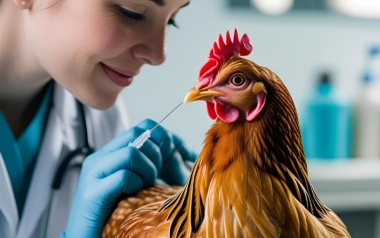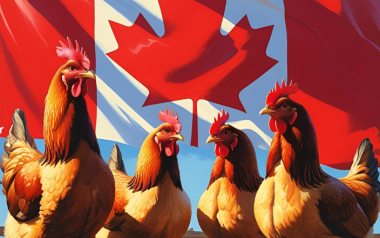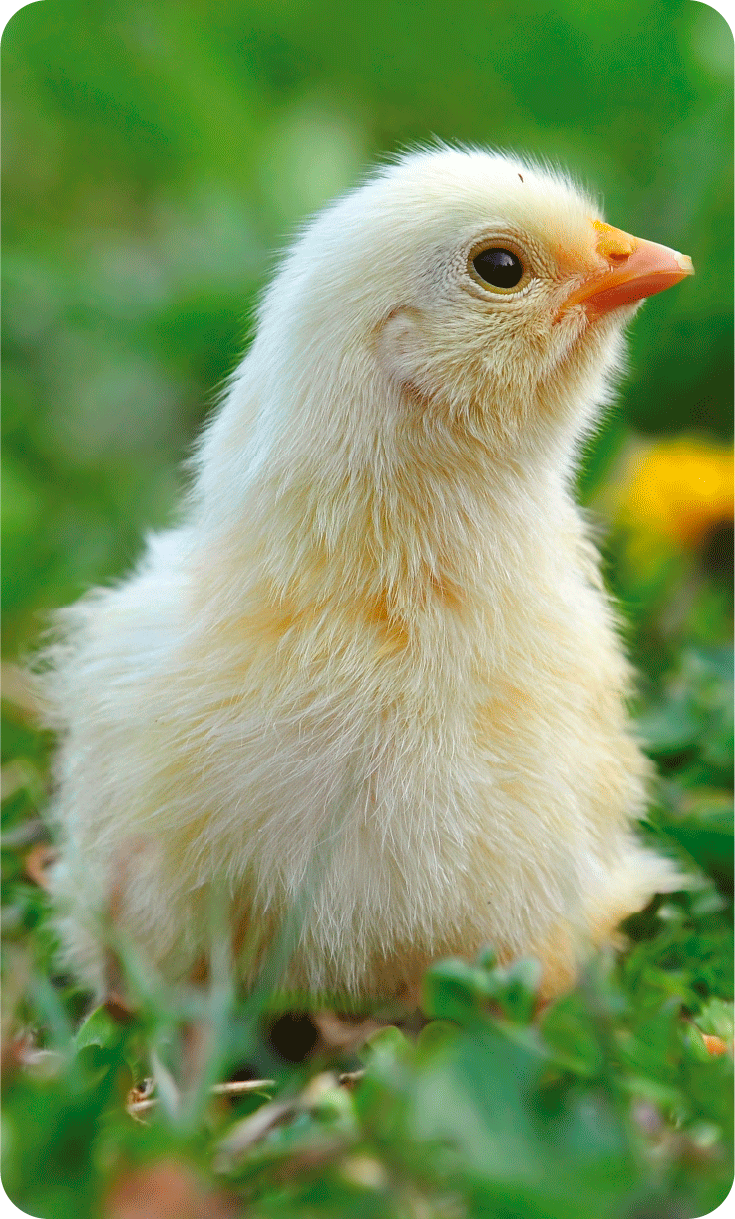18 May 2020
Control and prevention of Avian Influenza, a Latin American perspective
Content available at: Español (Spanish)Avian Influenza (AI) is a highly contagious and pathogenic viral disease of birds that is caused […]
Available in other languages:
Content available at:
Español (Spanish)
Avian Influenza (AI) is a highly contagious and pathogenic viral disease of birds that is caused by Type A Influenza viruses, with subtypes H5 and H7 being the most frequent responsible for outbreaks and epizootics in domestic birds worldwide.
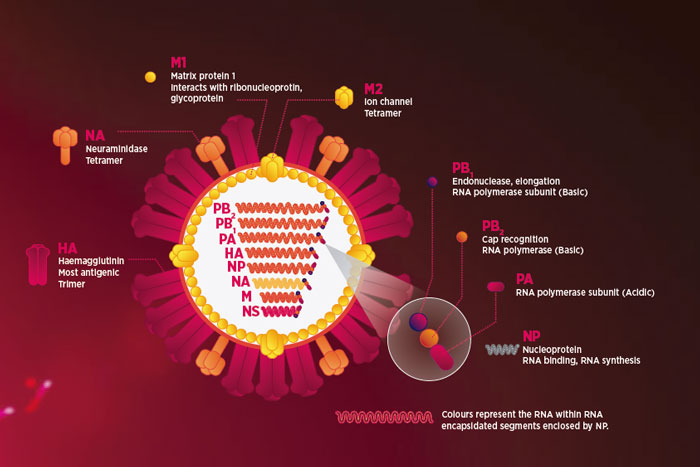
Figure 2. Anatomy of an Avian Influenza virus showing the eight genes that make up the virion: PB2, PB1, PA, HA, NP, NA, M and NS.
The first scientifically documented epizootic by veterinarian Edoardo Perroncito took place in the Italian Piedmont region in 1878, although there were reports of high mortality rates among birds over the centuries. This disease was initially known as Avian Plague.
Low & high pathogenicity
AI viruses belong to the Orthomyxoviridae family, with low and high pathogenicity variants. Highly pathogenic agents are those that have an Intravenous Pathogenicity Index (IPIV) equal to or greater than 1.2. Both low and highly pathogenic viruses are reportable and must be reported to the International Office of Epizootics (OIE) / World Animal Health Organization (OMSA) based in Paris, France.
Migratory birds
A concept of great importance in veterinary epidemiology is to take into consideration and know that migratory wild birds are natural hosts of AI viruses, which are generally characterized as low Pathogenicity viruses. For their part, domestic birds are hosts aberrant, since when a low pathogenic virus colonizes and infects them, these agents can mutate into highly pathogenic viruses, causing the disease with high morbidity and mortality rates.
AI outbreaks … globally!
Periodically and more frequently we receive reports of outbreaks and epizootics of Avian Influenza in the world geography.
- China
Such major epizootics caused by subtypes H5N1, H7N9 and H9N2 continue to circulate in China with the worrying ability that they may infect and even cause mortality in humans.
- Mexico & USA
Epizootics caused by the highly pathogenic H7N3 subtype in Mexico in 2012-2013, led to the slaughter and mortality of 30 million chickens. The panzootic disease caused by the highly pathogenic virus of Eurasian origin H5N2 in industrial poultry farming in the United States of America between 2014-2015, resulted in the mortality and slaughter of 48 million domestic birds and approximately one billion dollars per eradication costs and five billion dollars in total losses, in addition to the regrettable border closure for the export of chicken and eggs from the United States to the rest of the world. 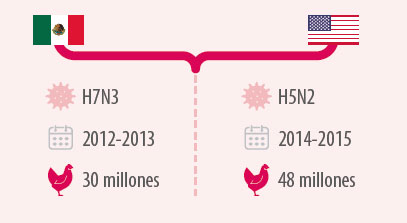
- Dominican Republic
Furthermore, we unfortunately have the most recent case of AI outbreaks in the Dominican Republic caused by the low pathogenic H5N2 subtype that occurred between 2017-2019.
- The official veterinary health services of each country should have a standing diagnostic capacity, together with appropriately trained personnel, and have a network of laboratories that may be capable of providing a rapid, timely and reliable diagnosis.
- Implementation of passive and active Epidemiological Surveillance campaigns throughout the year.
- In the event that the presence of a pathogenic AI virus is confirmed, and the fact of having had a timely and early report of the presence of a positive focus, will give the opportunity to the official veterinary health authorities to proceed to implement the quarantine of the infected farm(s) and to establish anti-epidemic measures establishing a focal area of 3 kilometers and a perifocal area of 7 kilometers (total 10 km).
- The National Association of Poultry Farmers, together with the Ministry of Agriculture and Livestock of each country, if possible, should raise awareness and have a sufficiently important fund of monetary resources to:
- Be able to guarantee the poultry producer in the event that their flock suffers from an unexpected drop in feed intake and an unusual high mortality.
- Encourage the poultry farmer to make the call to the state veterinary services, so that the specialized veterinarians appear on the farm(s) to investigate the case.
- The monetary fund will give the opportunity, certainty and security to the poultry farmer that, once the sanitary emergency has passed and in case his flock has been slaughtered, the farm owner can restart in due time his activities as a chicken or egg producer.
- The presence of a compensation fund encourages the timely reporting of an outbreak of avian influenza or other infectious disease in a poultry or livestock establishment and is key in the prevention and control of AI.
When these measures and actions have been implemented in a timely manner, with all disciplines of professionalism, economic resources and technological knowledge, it will be possible to avoid the spread of AI outbreaks in a geographic region – such as in the United States, Canada and the Netherlands, to mention some recent ones.
In most of the cases that we have known and witnessed during the last decades, this has not happened, since the AI virus has inexorably spread to the rest of the country’s commercial poultry, forcing the difficult decision to vaccinate all the country’s flocks, with serious drawbacks such as the impossibility of being able to export to other countries, forcing the need to import chicken meat and table eggs to satisfy market demand.
Experiences in Latin America
The Latin American Subcontinent has fortunately remained free of Avian Influenza virus throughout the years, with the exception of three countries: Mexico, Chile and the Dominican Republic, as previously mentioned.
- The Mexican case
The first avian influenza epizootic caused by a High Pathogenicity Orthomyxovirus Type A, Subtype H5N2, occurred in Mexican industrial poultry farming in late 1984, having rapidly spread to the central part of the country during the first half of 1985.
There were no initial reports of the first outbreaks by poultry producers to official health authorities.
When the first counter-epidemic measures were implemented in order to locate and quarantine the outbreaks by sacrificing infected flocks and controlling mobilization, it was already too late, as eleven states in the center of the Mexican Republic had tested positive to the serological tests of Hemagglutination Inhibition and Double Diffusion in Gel Agar. In those times, molecular biology tests such as PCR were not yet available in official and private diagnostic laboratories. 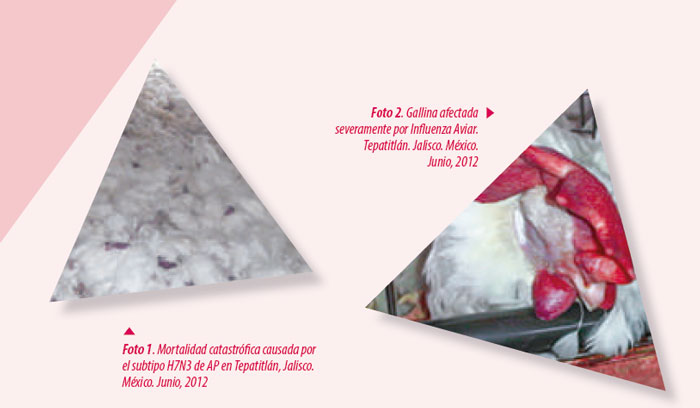
Currently, in addition to inactivated oil vaccines, immunogens developed with the new technology of Reverse Genetics are being used, which have greatly helped to provide better immunization of commercial birds in the field.
Vaccinate or not vaccinate?
Given this serious situation, both the National Union of Poultry Farmers of Mexico, as well as the General Directorate of Animal Health of the Ministry of Agriculture and Livestock of this country, were forced to make the historic decision of vaccinating flocks in areas not infected, in order to contain the epizootic. An inactivated oil vector vaccine was developed from which 0.5 ml was applied subcutaneously to the posterior medial part of the neck.
The second great epizootic occurred in a surprising way in the Altos de Jalisco region in western Mexico in June 2012, in a highly concentrated area where there was a population of 70 million hens in cage production. The causative agent was a high pathogenicity Subtype H7N3 virus. Despite severe containment measures, slaughter, control of mobilization, and vaccination of healthy flocks within a few months, the disease spread slowly but surely to neighboring states.
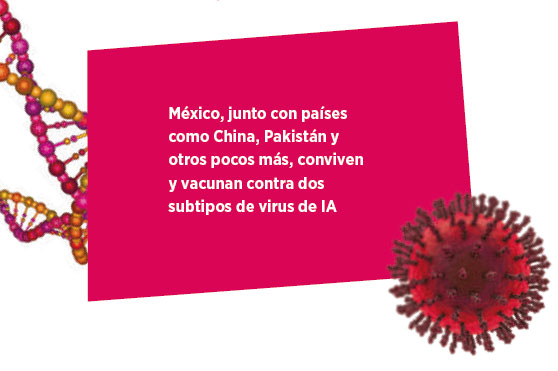
- Chile
Chilean poultry farming is an exceptional case in South America, as it suffered a sanitary emergency due to H7N3 high pathogenetic AI, between May and June 2002, in the Central Region of Valparaíso. Having the situation controlled rapidly and successfully in a period of three months; six months later, Chile declared itself officially free of the disease to the OIE and to countries to which it exported poultry products. In January 2017, the presence of AI in turkeys was reported in Quilpue and in Nogales, Valparaíso Region by Subtype H7. The birds were slaughtered and the outbreaks were properly controlled and closed.
- Dominican Republic
In November 2007, the presence and isolation of a low pathogenic A / H5N2 virus was reported in fighting cocks in Higuey, Alta Gracia Province, located in the eastern end of the island. The outbreaks that spread to commercial birds in the center of the country were identified, quarantined and depopulated in early 2008. The health emergency was closed in the middle of that year. However, ten years later, in October 2017, new AI outbreaks were presented and identified in commercial birds in the north and center of the island caused by the low pathogenic H5N2 subtype and in March 2019 the decision was made to proceed to the vaccination of Dominican poultry at the national level, in order to stop the spread of the disease.
- Brazil
It is extraordinary, surprising and miraculous that Brazil, being the second largest producer of broiler chicken and the first global exporter of chicken meat, with a production of 6.4 billion heads of chicken per year, with 50 million broiler breeders and with 110 million egg-laying hens in 2018, displayed no positive serologies or viral isolations of AI during these last years.






